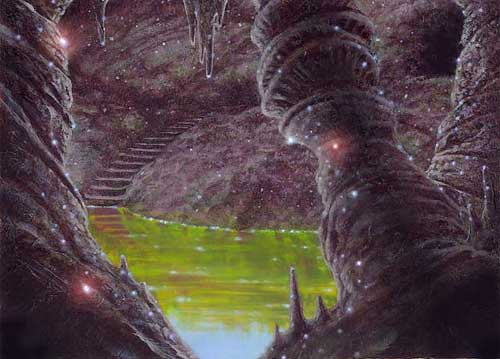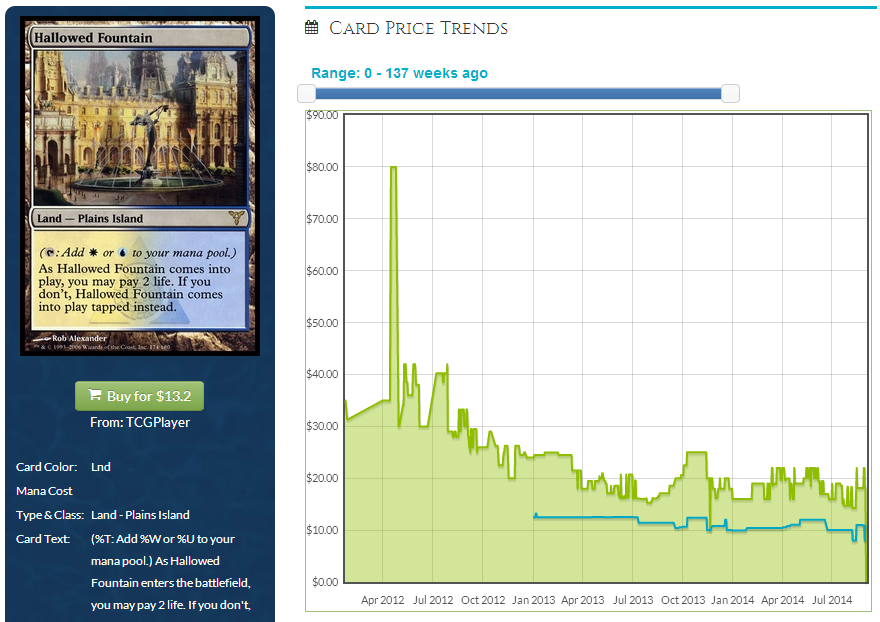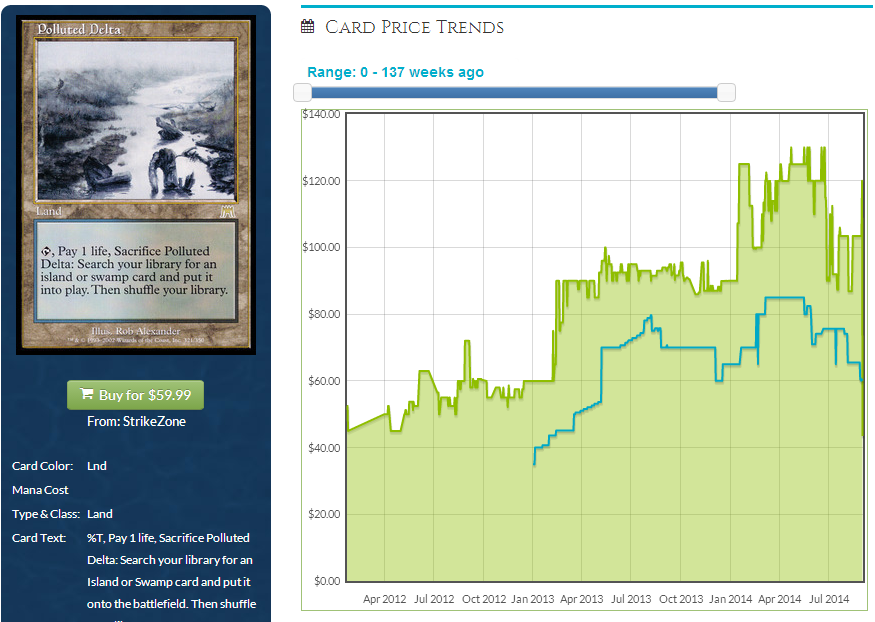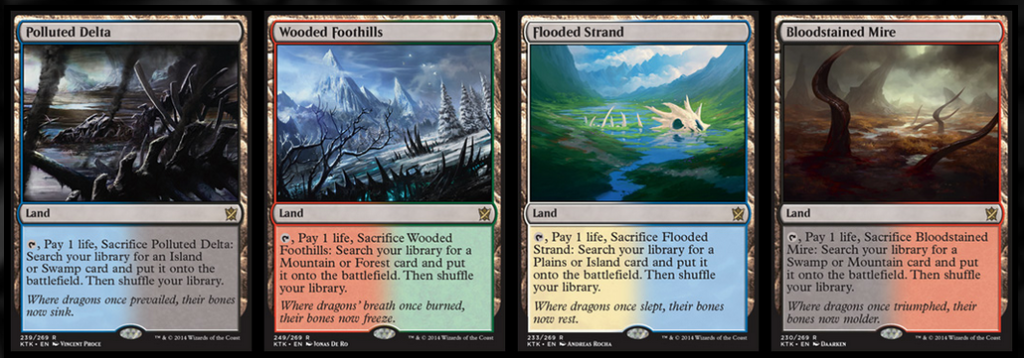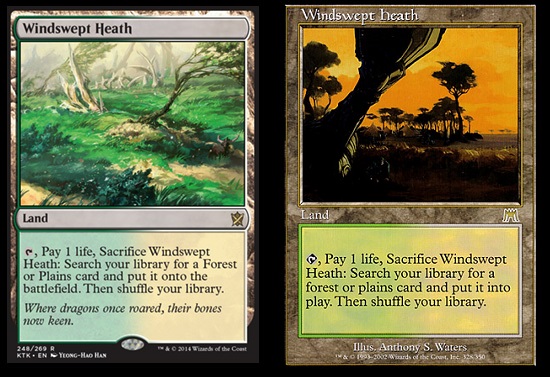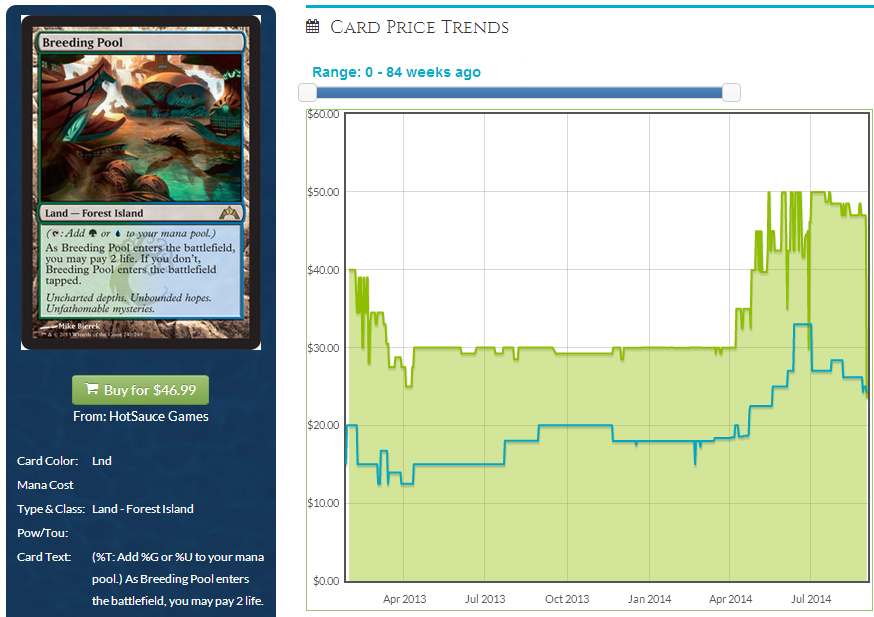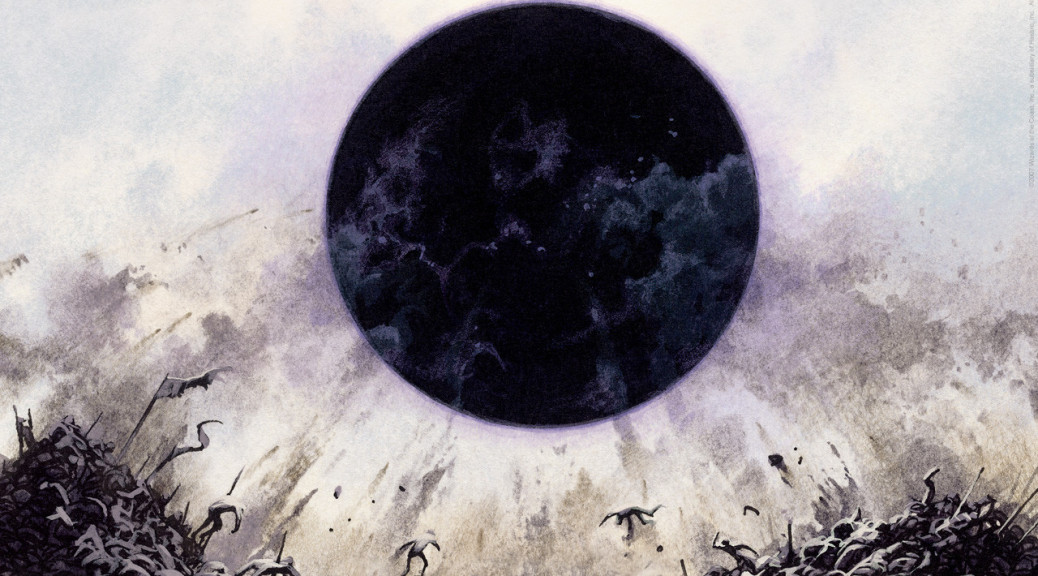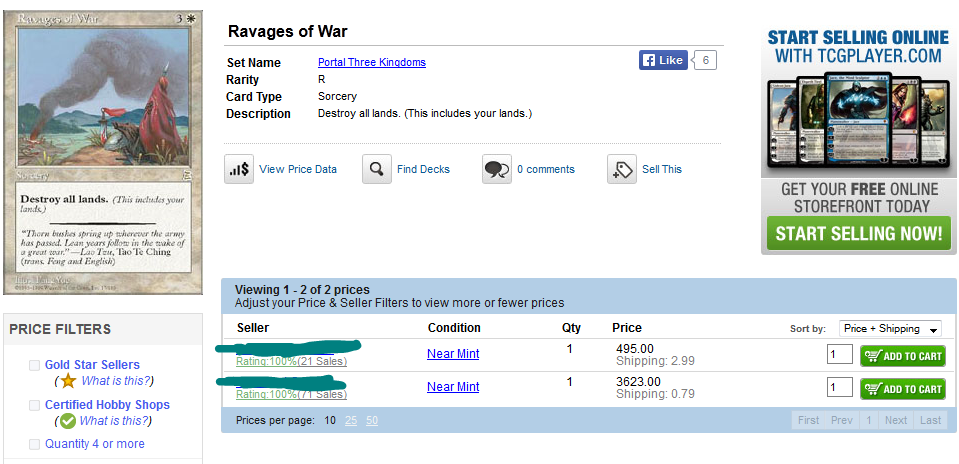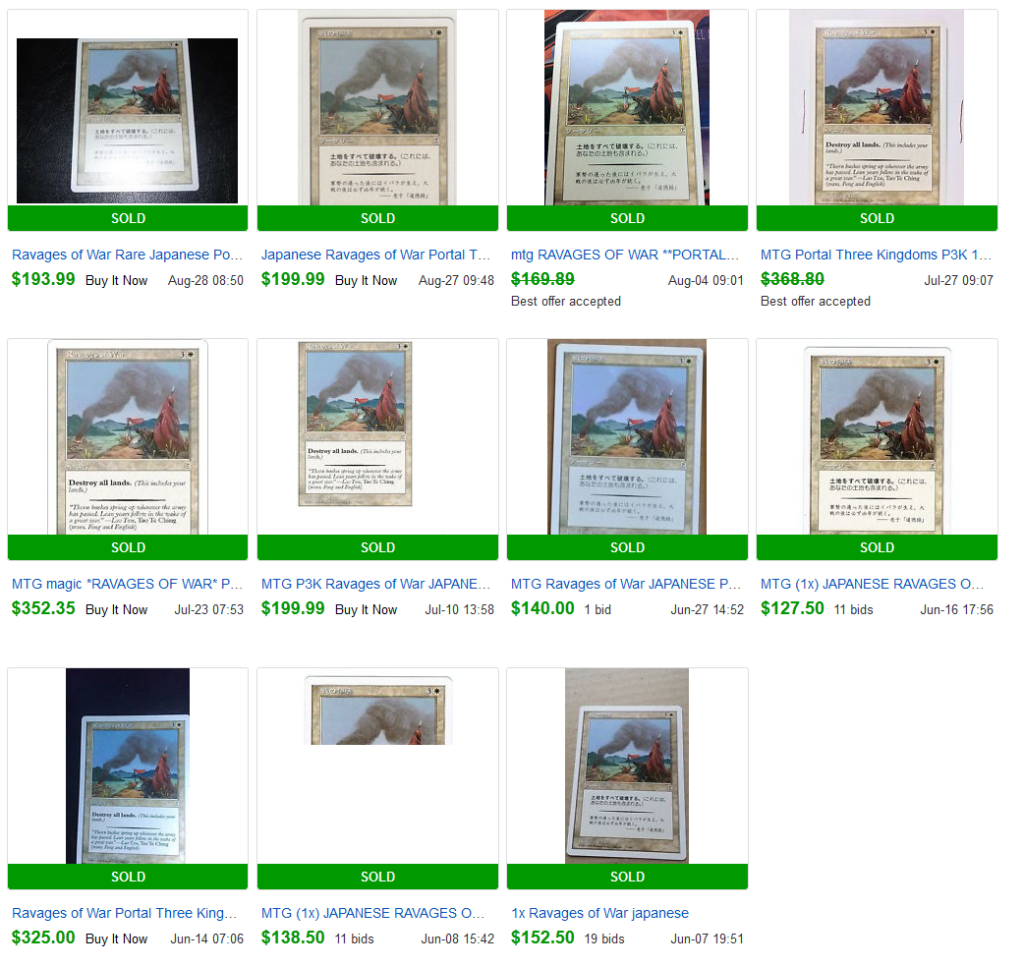Jared is on vacation this week, so in the meantime enjoy this piece he originally wrote on March 3rd, 2014.
By: Jared Yost
This one goes out to you casual players. You’re the heart of the game and the reason why Wizards has continued to become more and more successful as the years go on.
Let’s face it, without casual demand like players buying individual booster packs Wizards would close their doors sooner rather than later. The demand for the game and its cards cannot be sustained by the singles market alone. Sure, more financially minded players realize that it is a losing game to keep cracking packs in the hope that you’ll score at least three Brimaz, but for many players the act of opening a pack, smelling the cards, and going through each one and even sometimes being surprised by a valuable card in the pack can’t be understated. There is a reason that Magic’s de facto comic strip is called Cardboard Crack. We can all be severely addicted to our hobbies and Magic doesn’t escape this phenomenon.
One of the ways I learned to save money playing Magic was to stop cracking packs since it is one of the most inefficient ways to acquire valuable cards for your collection. As a casual player though, finance is the last thing on your mind. One of the main reasons that you play the game is to crack packs. Cracking packs is so awesome that they created the Limited format based on around it, because even binder grinders and highly competitive players need a way to crack packs other than to just open them. Not you. You’re just fine with crackin‘ ‘em open, and the more the better. What I’m now going to tell you is that there is a way for you to still satiate your addiction while not throwing value out the window, but it isn’t for the faint of heart.
As players, we can capitalize on our own addiction by setting aside a booster box from each set we want to purchase and then later sell them down the road at a profit as sealed product. Now, I realize that the temptation of opening that booster box may be too much for some of you, yet a very clear pattern that has emerged from sealed product is that it is bound to go up in value over the years.
Getting Value from Booster Boxes
Sealed product has a proven history of going up in value and booster boxes are the prime example of this. Setting aside a booster box from each set you want to buy is a great way to pay your way forward in Magic. If you’re going to buy two booster boxes when a set comes out and maybe even get a deal then, why not set one aside in your closet and sell it a few years later when it has doubled or more in value? A lot of people even purchase cases though this is too rich for my blood. Why not set aside two booster boxes, even three booster boxes from a case?
Let’s do the math for Innistrad, which is a fairly recent set and follows this trend. These were the preorder prices for Innistrad before it came out September 30th, 2011:
If we bought a case:
$519.95 + ~$20 shipping = $539.95 total
$539.95 / 6 boxes = $89.99 per box
If we bought two boxes (closer to an actual causal purchase):
($89.75 * 2) + ~$8 shipping = $187.5
-
This purchase is more expensive per box (~$93.75 per box) but cheaper overall.
It’s now the current day and we loved drafting Innistrad. We want to do a few triple Innistrad flashback drafts of the set. (None of that Dark Ascension nonsense, we’re pure Innistrad only!)
Now that we know how much this would have cost us when preordering, let’s find out how much it would cost us now:
Holy moly what a difference!
Case:
$1067 per case (which is the only seller, it could easily jump up in price again.)
+ ~$20 shipping = $1,087 total
$1,087 / 6 boxes = $181.17 per box
Two Boxes:
($169.99 * 2) + ~$8 shipping = $347.98
If you could afford the initial purchase up front back in 2011 two booster boxes of Innistrad today was worth 64% of a case if preordered when the set came out! If you could restrain yourself and set aside three booster boxes, you would have recouped 94% of what you originally spent. Not too shabby for basically doing nothing and still cracking three or four booster boxes.
If you bought two booster boxes of Innistrad back in 2011 and then set one aside in a closet until now you could sell it and reclaim 91% of your initial purchase in 2011. The second booster box has practically paid for the first one.
For the more financially minded, this probably seems pretty obvious. “Duh, the set is out of print, of course I can sell boxes at a premium.” What most people don’t realize however is that this is one of the safest ways to make money from Magic. That’s right, even sealed product like booster boxes isn’t off the table when it comes to picking things that gain value. It might take you a while to find a buyer but this is probably the lowest risk call you can make as a speculator that will guarantee you a return. It’s basically the index fund of the Magic world.
Let’s look at Return to Ravnica, which I’m sure most of you are definitely familiar with and see if the trend holds for more recent sets. Here are prices from September 2012:
Back in September 2012, you could preorder Return to Ravnica for basically the same cost as Innistrad (though cases seem to be pricier). I note this because sometimes Wizards will increase their pack price MSRP. The last increase was when packs went from $3.25 to $3.99 MSRP when Time Spiral was released in 2006. Thankfully this has not happened in quite a while, though it makes me feel like they may increase their pack price soon.
Anyways back to the math:
Case:
$535.99 per case + ~$20 shipping = $555.99 total
$555.99 / 6 boxes = $92.67 per box
Two Boxes:
($89.94 * 2) + ~$8 shipping = $187.88 ($93.94 per box)
Again, boxes are slightly more expensive when bought individually because sellers will charge more for shipping individual boxes.
These are the current prices today:
Hmm, they haven’t gone up in value too much. If we go by the lows:
Case:
$565.00 per case + ~$20 shipping = $585.00 total
$585.00 / 6 boxes = $97.50 per box
Two Boxes:
($92.49 * 2) + ~$8 shipping = $192.98 ($96.49 per box)
From these calculations for Return to Ravnica then and now we can see:
1. It seems like the price has remained stagnant for Return to Ravnica boxes so far since it only went up $3, unlike Innistrad which doubled.
2. Buying Return to Ravnica in case form today is noticeably more expensive than buying it per box if you were to just buy six boxes. Usually individual boxes are more expensive compared to box price per case. I’m predicting this is because the set is currently in a state of flux, where vendors may have lowered their box prices to get them out the door to make room for future product. We can see this with Cataclysm Games, where if you buy six boxes (($92.95 * 6) + ~$10 shipping = $567.7) versus a case ($569.95 + $10 shipping = $579.95) you’re actually saving $12.25.
3. If we preordered a case and saved three boxes, or preordered two boxes and saved one, we have yet to see a significant return on that investment 1 year, 5 months later. We only gained ~$5 per box if we ordered by the caseload and only ~$2.50 per box if we bought individual boxes. This leads me to believe that there is a lot of Return to Ravnica product out there.
We seem to have conflicting evidence. On the one hand Innistrad has gained significant value but on the other hand Return to Ravnica has not. Am I missing something here? Was Innistrad that much more popular than Return to Ravnica? (Well, I do think that triple Innistrad draft is still a popular format at this point and is more popular than triple Return to Ravnica draft (Pack Rat!)). Was Innistrad printed significantly less than Return to Ravnica? Is that two year birthday for a set that important? Maybe a little of all these reasons is why Return to Ravnica sealed product has stagnated.
One reason I’d venture to guess that Innistrad has climbed up in price so quickly is that it has valuable eternal staples like Liliana, Geist, and Snapcaster. Return to Ravnica currently does not contain as many valuable eternal staples.
My best guess though? Not enough time has passed. Given enough time Return to Ravnica will go up in value. If we use the index funds example, you’re looking just to outperform the market, not become the next penny stock mega winner. (That is, pick up a random $0.20 rare and hope that it spikes to $10+.) There is no doubt in my mind that Return to Ravnica is a very popular set and I am sure in time this will become evident as the price of RtR sealed product goes up. It just looks like hitting that 2nd birthday is the important defining characteristic of the price bump for booster boxes.
Getting Value from Other Casual Products
Another way you can tell that casual players are so important is because Wizards has been releasing new products on a more consistent schedule than ever before in their history. Back in the day, we were lucky to get a core set once every two years (which everyone hated because it only consisted of reprints) and the three block sets of the year (one big set in the fall, and two smaller sets spaced out through winter). This lead to a lot of stagnant Magic. It was easy to get bored. This created cycles of people leaving the game then coming back later once more unpopular sets rotated from Standard.
These days more people are coming back to the game than ever and they’re staying. Combine this with the addition of all the brand new players per year and you have a recipe for success. Let’s go over some of the ways that Wizards has catered to the casual crowd:
Commander Decks (Commander 2011, Commander 2013)
Here were the price of Commander Decks in 2011 about six months after they came out:
Here are what they are today:
(Heavenly Inferno is currently ending on auctions at anywhere from $90 for non-English versions to up to $200 for English versions)
Very obvious upward trend in prices. Even if you bought the unpopular commander decks at the time (that is, the decks without Legacy staples in them) you still made out like a bandit if you waited to sell. They were all selling for about MSRP even six months after their release.
This is why a lot of Magic financiers recommended for Commander 2013 to even buy the non-Mind Seize decks. Even though the rest of the decks didn’t seem to have much to offer Constructed formats, casuals don’t give two craps about constructed potential. They just want to attack you with their angels, demons, and dragons as fast as possible. I see no reason why the current batch of commander decks won’t also follow this pattern as they age.
Planechase / Archenemy / Duel Decks (essentially, all the products that MSRP’ed for $19.99)
Archenemy – June 2010 MSRP $19.99
Today’s prices:
Planechase 2009 – MSRP $19.99
Today’s prices:
Planechase 2012 – MSRP $19.99
Today’s prices:
Duel Decks
|
Duel Deck |
Current Price |
|
Elves vs. Goblins |
$200.00 |
|
Jace vs. Chandra |
$130.00 |
|
Divine vs. Demonic |
$170.00 |
|
Garruk vs. Liliana |
$65.00 |
|
Phyrexia vs. The Coalition |
$32.00 |
|
Elspeth vs. Tezzeret |
$40.00 |
|
Knights vs. Dragons |
$50.00 |
|
Ajani vs. Nicol Bolas |
$43.00 |
|
Venser vs. Koth |
$25.00 |
|
Izzet vs. Golgari |
$25.00 |
|
Sorin vs. Tibalt |
$19.00 |
Planechase / Archenemy / Duel Decks Price Analysis
Popular casual products are the single-deck sealed products which are Commander, Planechase, and Archenemy. These products offered more than just decks because Planechase and Archenemy have oversized cards (which also have value if you try to sell them individually) and Commander added brand new cards to the existing card pool. On the other hand, Duel Decks seem to be hit or miss. I think this is because they only consist of reprints and that Wizards seems to have been watering down the most recent ones by not including more powerful spells like the ones found in Divine vs. Demonic or Jace vs. Chandra.
In other words, you shouldn’t pick up extra Duel Decks unless there is something special in them (Demonic Tutor and Counterspell with Jace art are good examples). They take the longest to go up in value and the gains factored in with the time it takes are too long for the profits to matter.
If you’re interested in holding on to extra sealed product for value you want to be looking at picking up Commander, Planechase, and Archenemy (if they do Archenemy again) products. All of these products have evidence showing they go up in value over time.
Casual Players Are Important
Without casual players we would have no one to crack individual packs. Without cracking packs booster boxes would never become valuable. We would also have no one to buy other sealed products that Wizards releases because they look cool or add new aspects to the game in a non-competitive fashion. This would make buying the sealed products Wizards releases a complete waste of money if you’re trying to hold them for value. This clearly isn’t the case. We’re lucky to have such an amazing fanbase behind Magic because without them the game would surely go away. From a numbers perspective, we can see that all it takes to capitalize on Magic’s fanbase is to hold onto a few extra sealed products here or there.
Casual players, you may not realize it but buying these products is itself an investment in the game. Even if you are just buying the products to play with, with no intention of wanting to buy extra to sit on them or make money, my advice to you is to buy what you want as soon as you can afford it. Sealed products are never going to be cheaper than when they first come out, no matter if you’re eyeing something like a booster case or even just considering picking up a duel deck. If you ever have the inclination to help your hobby pay for itself, pick up a few extra sealed products and sit on them. Eventually you can cash them out to cover the costs of buying in even if that is a few years down the road. I believe the evidence that I’ve presented in this article has more than proved that in all cases.
The upcoming Conspiracy set is one of the reasons I’m writing this article. I would definitely be looking to pick up as much Conspiracy as I can and holding whatever I choose not to open. It looks like it is going to be another huge casual hit that will certainly go up in value over time.















